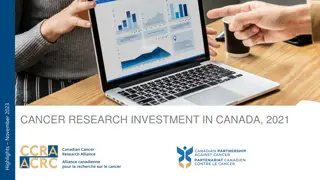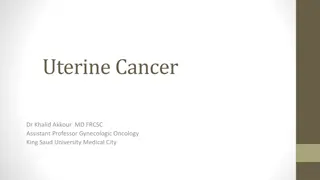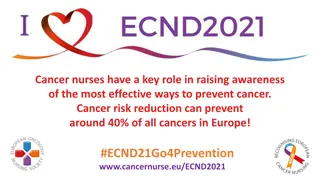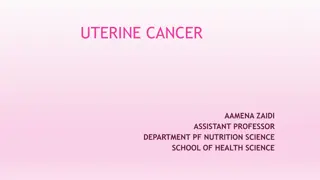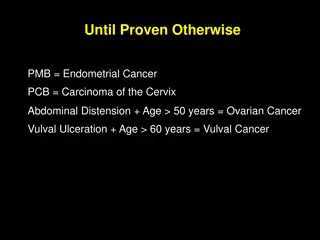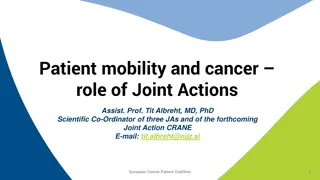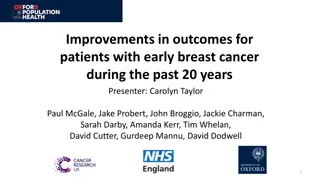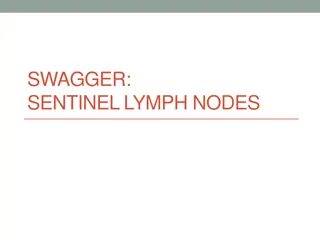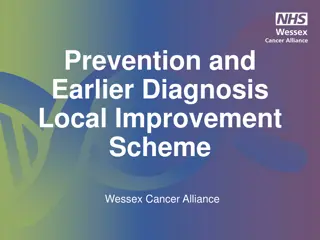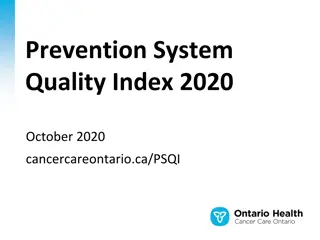Understanding Endometrial Cancer: Risk Factors, Diagnosis, and Management
Endometrial cancer, the most common gynecological malignancy in women, presents with abnormal uterine bleeding and affects women mainly during menopause. Risk factors include hormonal stimulation and estrogen levels. Differentiating between types of endometrial cancer can impact treatment decisions. Endometrial hyperplasia, a precursor to cancer, has varying progression rates to malignancy. Proper diagnosis and staging are essential for effective management of endometrial cancer.
Download Presentation

Please find below an Image/Link to download the presentation.
The content on the website is provided AS IS for your information and personal use only. It may not be sold, licensed, or shared on other websites without obtaining consent from the author. Download presentation by click this link. If you encounter any issues during the download, it is possible that the publisher has removed the file from their server.
E N D
Presentation Transcript
Endometrial Cancer Dr. Khalid Dr. Khalid Akkour Akkour MD FRCSC MD FRCSC Assistant professor and consultant Assistant professor and consultant Gynecologic oncologist Gynecologic oncologist Department of Obstetric and Gynecology Department of Obstetric and Gynecology College of Medicine, King Saud University College of Medicine, King Saud University
OBJECTIVES Describe the classification of uterine malignancy. Learn how malignant disease of the uterus presents. Describe which endometrial cancer. investigations are needed for women with suspected Know Obstetrics the International (FIGO) staging of Federation of endometrial cancer. Gynecology and Understand how endometrial cancer is managed.
Endometrial Cancer Themost common gynaecological malignancy womenwith an age related Thelife-time risk of developing approximately1 in 46. Themean age of diagnosis is 62 years, although cancers be diagnosed in women throughout Approximately 25% of endometrial cancers menopause. affecting UK incidence of 95 per100,000 women. endometrial cancer is can their reproductive life. occur beforethe
Risk factors Risk related to hormonal stimulation or unrelated to estrogen at all. Estrogen-related endometrial cancer (Type I) tends to be a lower grade histologically. Endometrial cancers unrelated to hormones (Type II) tend to be a higher grade and stage eg. Papillary serous or tumors. clear cell
How endometrial hyperplasia is associated with endometrial cancer Endometrial hyperplasia is a continum Simple hyperplasia complex hyperplasia without atypia complex hyperplasia w/ atypia endometrial cancer (well differentiated adenocarcinoma)
How endometrial hyperplasia is associated with endometrial cancer Simple hyperplasia without atypia 1% progress to endometrial cancer Complex hyperplasia without atypia 3% Simple hyperplasia with atypia_ 10% Complex hyperplasia with atypia 28%
Clinical presentation The classic symptom is abnormal uterine bleeding 20-30% of women with post-menopausal bleeding will have uterine cancer.
Diagnosis Easy to do with office EMB Hysteroscopy w/ D & C (gold standard) Detection rates of endometrial ca. by pipelle was between 91 and 99% Detection of hyperplasia was 81% Recommendation: EMB as initial test; Hysteroscopy/D&C if EMB inconclusive or high suspicion (hyperplasia with atypia, pyometria, presence of necrosis, or persistant bleeding)
Transvaginal ultrasound In postmenopausal women, an endometrial thickness of 4-5 mm or less is pretty reassuring. (only 1% will have endometrial ca. if normal endometrial thickness) ?? If normal TVS do you need an EMB w/abnormal bleeding. A thicker endometrium requires EMB, hysteroscopy/D&C Especially useful for women on estrogen who have bleeding who have bleeding, but overall TVS is not recommended as a screening tool.
Cancer Staging Staging is always done surgically Requires a total hysterectomy, BSO + PLND
Cancer Staging Pre-op imaging CXR CT CAP
Cancer Staging Labs CA-125 LFT s , RFT s CBC
Other risk factors for endometrial cancer Familial predisposition Eg Lynch syndrome II : hereditary nonpolyposis colorectal cancer (HNPCC), endometrial carcinoma. (up to 43% of women of affected families will develop ovarian cancer)
Other risk factors for endometrial cancer Parity Nulliparity in and of itself is not a risk factor as much as the anovulatory cycles that are associated with infertility Diet especially high fat Menarche/Menopause: early menarche and late menopause essentially prolonged estrogen exposure protection of progesterone. without the
Protective Factors Oral contraceptives: Decreases both the risk of ovarian and endometrial cancer (RR = 0.6 if used for one year effect lasts for 15 years!) Protective effect probably due to progesterone.
Histopathology Most common types of endometrial cancer: Endometriod adenocarcinoma (70-80%) Clear cell and serous tumors are more aggressive and probably present at a more advanced age. (together 5-10%) Mucinous and squamous about 2%









